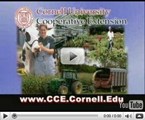The following story is from SARE, Sustainable Agriculture Research & Education, whose mission is to advance—to the whole of American agriculture—innovations that improve profitability, stewardship and quality of life by investing in groundbreaking research and education.
Karl Kupers saw improved water-use efficiency on his 4,400-acre eastern Washington grain farm when he replaced a wheat/fallow system with expanded crop rotations and no-till seeding.
In western Colorado, crop farmer Randy Hines developed a tillage tool that leaves vegetative residue on the soil while creating irrigation furrows in every other 30-inch row. He saved water by using half the typical number of irrigation furrows and saved money through fewer tractor trips across his fields.
Illinois farmer Ralph "Junior" Upton broke up a 6- to 8-inch layer of compacted clay by planting cover crops after soybean and corn harvests, thereby enhancing his soil's ability to store water for upcoming crops.
With drought conditions gripping more than half the United States this summer, water-saving strategies are more critical than ever for America's farmers and ranchers. That is why SARE's 16-page bulletin, Smart Water Use on Your Farm or Ranch, is an excellent primer on conservation-oriented approaches to water use. Check out http://www.sare.org/Newsroom/Press-Releases.
Smart Water Use on Your Farm or Ranch spotlights innovative, SARE-funded research into a range of conservation options including soil management, such as using compost, conservation tillage and cover crops; plant management, featuring crop rotation, water-conserving plants and rangeland drought mitigation; and water management strategies such as low-volume irrigation and water recycling.
The bulletin also features farmers like Kupers, Hines and Upton who are managing soil to improve infiltration, selecting drought-tolerant crops and native forages, and designing innovative systems for tillage, irrigation and runoff collection.
At the end of the bulletin is a list of resources where readers can get more in-depth information.
Because there is a wide range of soil management practices that can have a significant impact on water use and availability, these other SARE titles offer important guidance to farmers and ranchers concerned with water issues:
Building Soils for Better Crops, 3rd Edition
Managing Cover Crops Profitably, 3rd Edition
Crop Rotation on Organic Farms
Other resources available through SARE include:
The Ogallala Aquifer of the Texas High Plains: A Race Against Time - This SARE-produced video highlights the work being done by Texas researchers, farmers and ranchers to conserve water by replacing monocultures with diversified crop/livestock systems.
Irrigation Energy Webinar Series - These three videos, produced with a SARE grant by University of Wisconsin Extension Specialist Scott Sanford, describe how to ensure your irrigation system is operating at maximum efficiency.
Rainwater Catchment from a High Tunnel for Irrigation Use - This Iowa State University Extension video, produced with SARE funding, describes how to build a system to catch, store and reuse the rainwater for irrigation in a high tunnel.
Water: The Foundation of Agricultural Sustainability Conference - This event co-sponsored by Western SARE on August 7 in Santa Fe, N.M. provided practical information on optimizing water-use efficiency for agriculture in the southwest.





